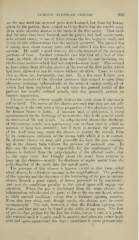Page 925 - My FlipBook
P. 925
CHRONIC ALVEOLAR ABSCESS. 935
see the case until the necrosed parts were loosened, but, from the history
^iven by the patient, there seemed to be no doubt that the trouble arose
from acute alveolar abscess at the roots of tlie first molar. That tooth
had for some time been decayed, and the patient had had severe tooth-
ache several times ; in one of these attacks the face began to swell, and
it was in this inflammation that the necrosis occurred. The patient was
a young man about twenty years old, and when I saw him was quite
antemic. He made a good recovery after the removal of the necrosed
portions of bone. Another extensive case was that of a boy of nine
years, in which all of the teeth from the cuspid to and including the
t\velve-year molar—which had not erupted—came away. This seemed
to have arisen from alveolar abscess at the root of the first molar, which
had been allowed to run its course without attention. Cases so exten-
sive as these are, f )rtunately, very rare. In a few cases I have seen
extensive necrosis of the alveolar processes that seemed to arise from
abscesses occurring independently at the roots of various teeth, all of
which had been neglected. In such cases the general health of the
patients has usually suffered greatly, and they generally present an
ansemic appearance.
Chronic alveolar abscess usually follows the acute form if the case is
left to itself. The causes of this abscess are such that they are not self-
limiting, as is the rule with a large proportion of the abscesses to which
the human frame is liable. A common boil, or phlegmon, is cured
spontaneously by the discharge of its contents ; this is the general result
in abscesses of the soft tissues. In subperiosteal abscess the discharge
of the contents results in a spontaneous cure in those cases in which no
necrosis of bone has occurred ; but if there is necrosis, the presence
of the dead bone may cause the abscess to assume the chronic form
by its continuous irritation of the tissues with which it is in contact.
In alveolar abscess we may, and generally do, have the case continu-
ing in the chronic form without the presence of necrosed bone. In
this case the irritant tliat is responsible for the continuance of the
abscess is derived from the pul])-chamber of the affected tooth ; that
is, the same cause that brought about the acute form remains to
keep up the chronic—namely, the discharge of septic matter from the
pulp-chamber of the tooth into the ajjical space.
The presence of this abscess is known, except in that form called
blind abscess, by a fistulous oj^ening in the neighborhood. The position
of this opening and the direction of the burrowing of the pus in chronic
abscess furnish a great variety of forms, presently to be considered
;
just now the conditions peculiar to the apical space will engage our
attention. When the pus is discharged from the acute abscess, the
inflammation subsides and the paji'ts, so far as the eye can detect, return
to their normal condition, except that a fistulous opening remains.
Even this may close, and, though rarely, the abscess may be ctu'ed
spontaneously. The rule, however, is that the fistulous opening con-
tinues, and that pus may be found at the orifice at any time. The flow
of pus is often profuse for the first few weeks, but, as a ride, it is gradu-
ally reduced until it is quite small in amount, tmd often the orifice heals
over and opens again every few days ; sometimes it closes permanently.


